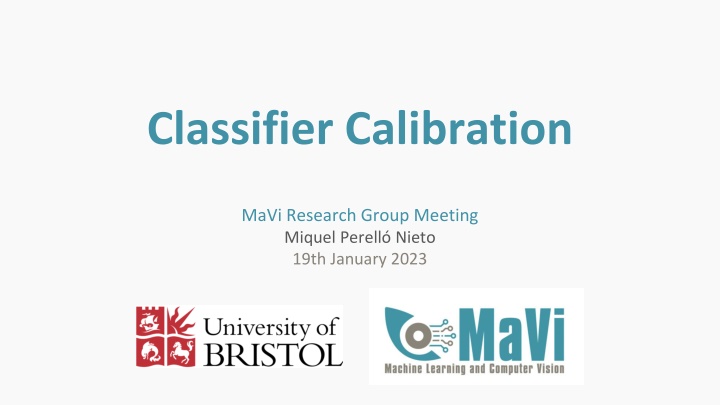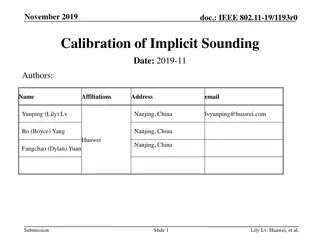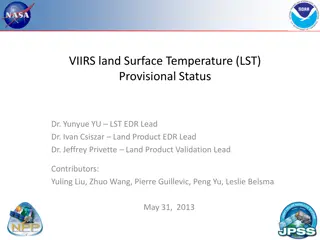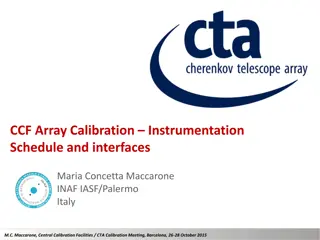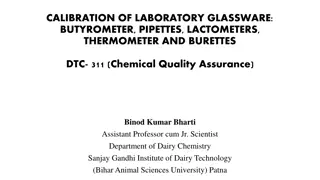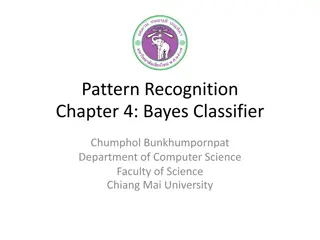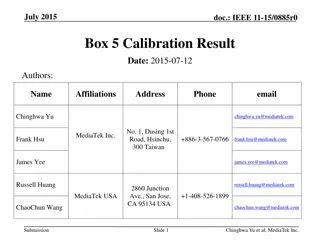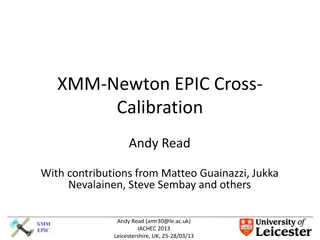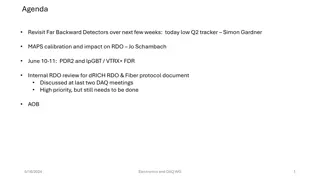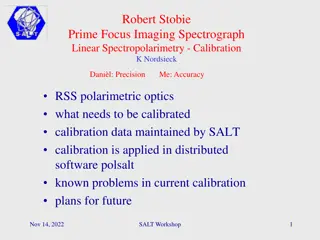Importance of Classifier Calibration in Data Science
Discussing classifier calibration, its significance, measurement methods, empirical evaluation of calibrated classifiers, and comparison of various calibration methods to ensure optimal decision-making in data science applications.
Download Presentation

Please find below an Image/Link to download the presentation.
The content on the website is provided AS IS for your information and personal use only. It may not be sold, licensed, or shared on other websites without obtaining consent from the author.If you encounter any issues during the download, it is possible that the publisher has removed the file from their server.
You are allowed to download the files provided on this website for personal or commercial use, subject to the condition that they are used lawfully. All files are the property of their respective owners.
The content on the website is provided AS IS for your information and personal use only. It may not be sold, licensed, or shared on other websites without obtaining consent from the author.
E N D
Presentation Transcript
Classifier Calibration MaVi Research Group Meeting Miquel Perell Nieto 19th January 2023
Classifier Calibration 1. What is classifier calibration? 2. Why is it important? 3. How to measure? 4. Are classifiers calibrated? 5. Calibration methods. 6. Conclusion. Table of content
(c) Reliability diagram 1. What is Classification Calibration? Deviation to diagonal indicates miss-calibration (a) Decision boundary and iso-hyperplanes of a probability estimator. (b) Projection to an orthogonal vector A probabilistic classifier is: (A) binary-calibrated if for any prediction q the proportion of positives among all instances x getting the same prediction are (B) multiclass-calibrated if for any prediction vector , the proportions of classes among all possible instances x getting the same prediction are
2. Why is calibration important? Optimal decision making Predicted True P. False Cost Matrix Population proportion 50% Actual True -1 100 50% Actual False 50 0 Changes on costs It also allows the decision to abstain Changes on class proportions Predicted True P. False Cost Matrix Abstain Population proportion 50 70% Actual True -10 90 30 30% Actual False 40 -5
3. How to measure calibration? Confidence Calibration Error Confidence-calibrated if Maximum Calibration Error counterparts Empirically measured as Calibration Error Per class Classwise-calibrated if Empirically measured as Every proper loss is minimised by the canonical calibration function (eg. log-loss and Brier score).
4. Are classifiers calibrated? Simple examples. - Empirical evaluation: - 21 datasets and 11 classifiers - 5 times 5-fold-crossval. p-cw-ece
5. Calibration methods 21 datasets, 11 classifiers = 231 settings to compare 8 calibration methods 5 times 5-fold-crossval and inner 3- fold-crossval Binary Multiclass p-cw-ece Empirical binning [1] Platt scaling [3] Isotonic regression [2] Beta calibration [4] Bayesian binning into quantiles [7] One-vs-rest counterparts Temperature scaling [5] Vector scaling [5] Matrix scaling [5] Dirichlet calibration [6]
1. Classifier calibration adjusts the probabilities output by a classifier to be more precise. 2. Optimal decision making under changing operating conditions. 3. Multiple measures with their caveats. 4. MLP, decision trees, SVMs with Platt scaling and ensembles are among the best calibrated classifiers. 5. Multiple calibration methods can still improve their estimations. Classifier Calibration Conclusion
References [1] Zadrozny, B., & Elkan, C. (2001). Obtaining calibrated probability estimates from decision trees and naive Bayesian classifiers. 18th International Conference on Machine Learning (ICML 01), 609 616. [2] Niculescu-Mizil, A., & Caruana, R. (2005). Predicting good probabilities with supervised learning. 22nd International Conference on Machine Learning (ICML 05), 625 632. [3] Platt, J. (2000). Probabilities for SV Machines. In A. J. Smola, P. Bartlett, B. Sch lkopf, & D. Schuurmans (Eds.), Advances in Large-Margin Classifiers (pp. 61--74). MIT Press. [4] Kull, M., Silva Filho, T. D. Menezes., & Flach, P. (2017). Beyond Sigmoids: How to obtain well-calibrated probabilities from binary classifiers with beta calibration. Electronic Journal of Statistics, 11(2), 5052 5080. [5] Guo, C., Pleiss, G., Sun, Y., & Weinberger, K. Q. (2017, June 14). On Calibration of Modern Neural Networks. Thirty-Fourth International Conference on Machine Learning. [6] Kull, M., Perello-Nieto, M., K ngsepp, M., Filho, T. S., Song, H., & Flach, P. (2019). Beyond temperature scaling: Obtaining well- calibrated multiclass probabilities with Dirichlet calibration. In H. Wallach, H. Larochelle, A. Beygelzimer, F. Alch -Buc, E. Fox, & R. Garnett (Eds.), Advances in Neural Information Processing Systems (pp. 12316 12326). Curran Associates, Inc. [7] Naeini, M. P., Cooper, G. F., Hauskrecht, M., Naeini, P., Cooper, G. F., & Hauskrecht, M. (2015). Obtaining Well Calibrated Probabilities Using Bayesian Binning. 29th AAAI Conference on Artificial Intelligence, 2015, 2901 2907
